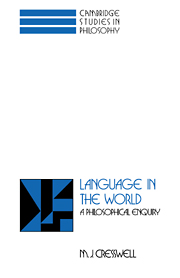Book contents
- Frontmatter
- Contents
- Preface
- Introduction
- 1 A simple formal language
- 2 Predicates and functors
- 3 The isomorphism problem
- 4 Quantification
- 5 Transmundism
- 6 Putnam's ‘Meaning of “meaning”’
- 7 Lewis on languages and language
- 8 Causation and semantics
- 9 Belief–desire psychology
- 10 Direct knowledge
- References
- Index
6 - Putnam's ‘Meaning of “meaning”’
Published online by Cambridge University Press: 01 October 2009
- Frontmatter
- Contents
- Preface
- Introduction
- 1 A simple formal language
- 2 Predicates and functors
- 3 The isomorphism problem
- 4 Quantification
- 5 Transmundism
- 6 Putnam's ‘Meaning of “meaning”’
- 7 Lewis on languages and language
- 8 Causation and semantics
- 9 Belief–desire psychology
- 10 Direct knowledge
- References
- Index
Summary
In this chapter I want to discuss whether the things said in Putnam 1975 affect the kind of possible-worlds semantics illustrated in the case of the very simple language ℒ introduced on pages 5f. Since Putnam's principal target is the use of the intension/extension distinction in semantics, and since that distinction is one which can be defined in if, at least in the case of predicates (see p. 29), it is important to see how Putnam's remarks affect what has so far been said. In the latter part of the paper (pp. 183–8) Putnam offers a critique of what he calls ‘California semantics’. The semantics I offered for ℒ is clearly within this tradition. This section of Putnam's paper is, however, less helpful than other parts. Putnam's principal argument against California semantics is that treating an intension as a function from worlds to extensions requires supplementing by giving an account of what it is to ‘grasp’ an intension. The reason this is for him an important criticism is that the role of intension in semantics that he is concerned with is that it is the means by which a speaker is able to determine the extension, and treating it merely as a function from worlds to extensions gives no help in explaining how it can fill this role. I need take no issue with this criticism since I have already stressed that nothing in the possible-worlds semantics offered for ℒ gives any help in saying what it is about speakers’ behaviour that determines which of the many possible interpretations for ℒ is the correct one.
- Type
- Chapter
- Information
- Language in the WorldA Philosophical Enquiry, pp. 72 - 93Publisher: Cambridge University PressPrint publication year: 1994

